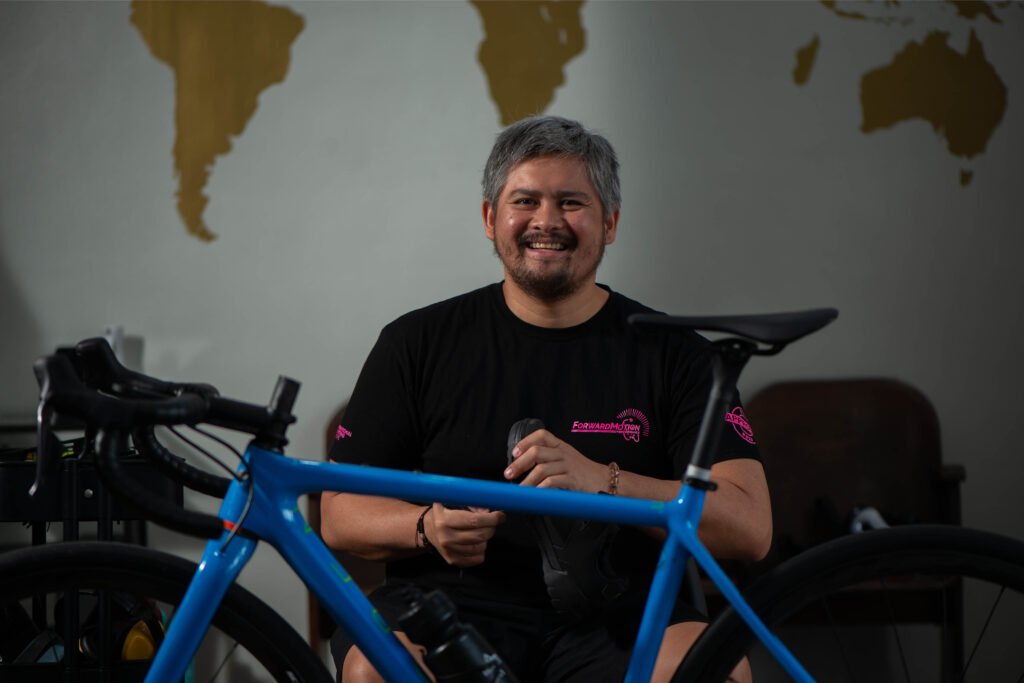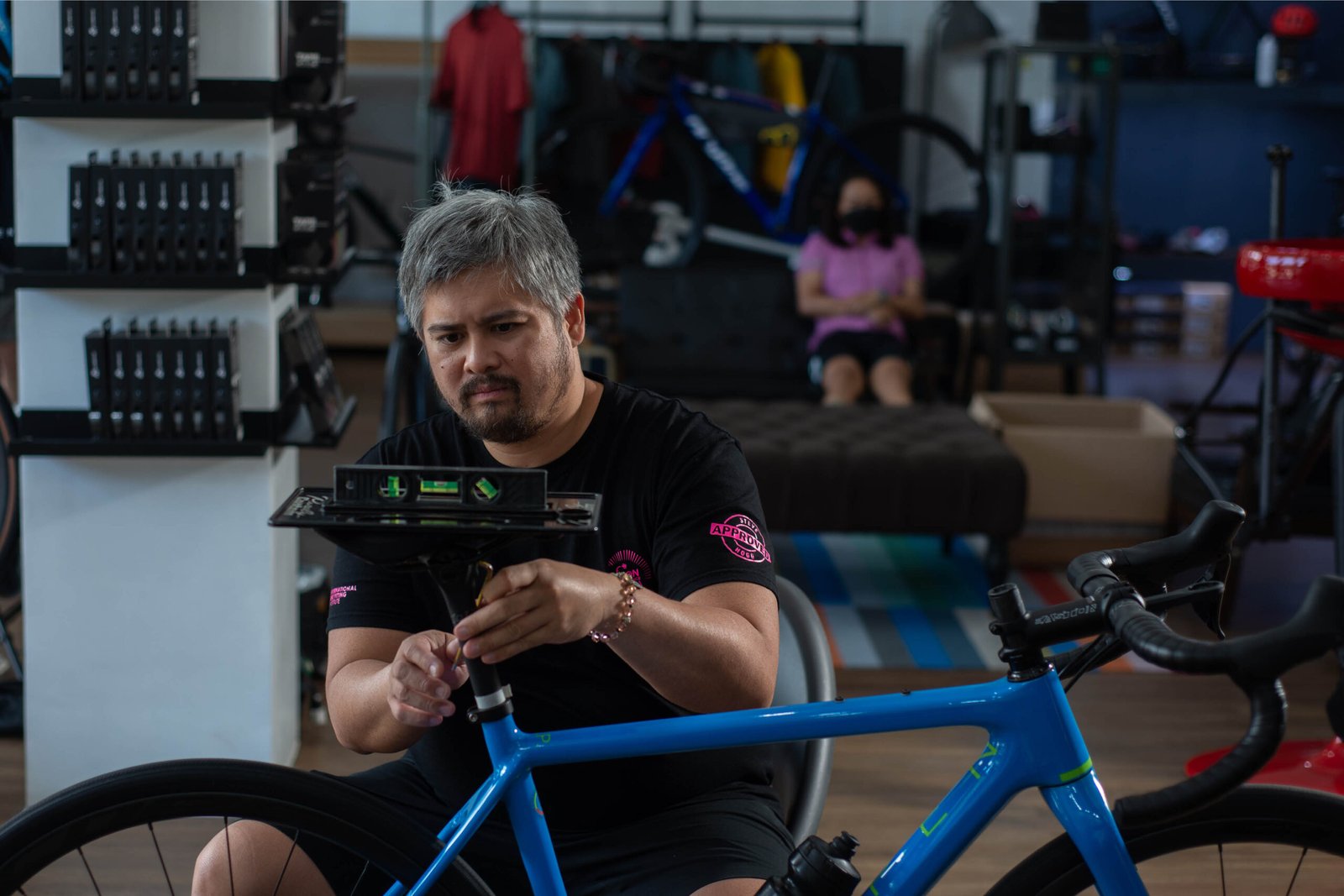Interview Patrick Kasingsing, with Gabbie De La Cruz
Images Greg Mayo
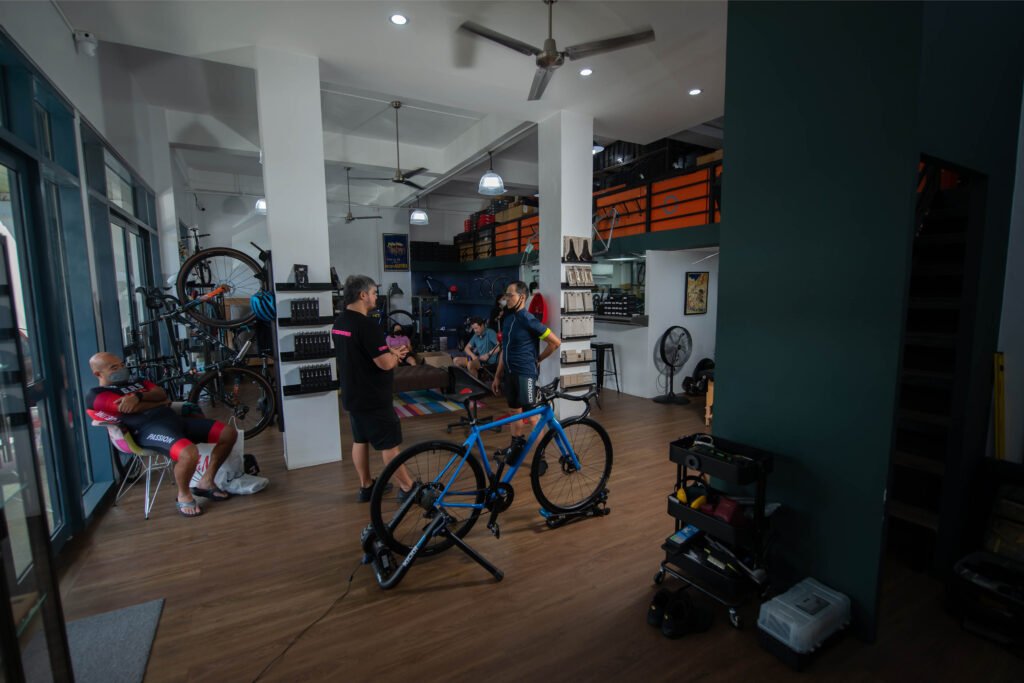

“The pandemic inadvertently helped save the local cycling industry,” says professional bike fitter Frederick Martin Ilagan of Forward Motion Performance, who has been working with the two-wheeled contraptions for over ten years but is a cycling enthusiast ever since he was in his teens.
“The biggest drawback that we long-time enthusiasts are seeing is that as the number of bikers increases, so does the number who do not know how to ride a bike properly,” he adds, saying that without proper riding ethics and road discipline, accidents and injuries are likely to occur. “I also believe not many bikers are getting the best out of their rides…regardless of the bike type, there is more potential in terms of speed, comfort, and physical gains to bring out with the proper bike customization,” Ilagan shares. “That’s where we bike fitters come in.”
Hello, Martin! Where have you been on your bike lately?
Frederick Martin Ilagan, founder, Forward Motion Performance: Honestly, I haven’t ridden my bike for quite some time. I think that’s the problem I have with my job. I get to work on a lot of my clients’ bikes, but I don’t get to ride my own bicycle (laughs).
As much as I want to, time won’t let me. I just live vicariously by seeing or hearing how my clients enjoy riding their bikes now after they visit the studio.
I’m sure you’ll find the time to get on your bicycle again in the future. Now, let’s travel back in time for a bit. Can you recount to us your first experience of riding a bicycle? What made you fall in love with bikes?
I started riding bicycles at a young age. I think it was during my 6th birthday when my dad bought me my first bike. It was a bicycle for children that came with a sidecar. Back then, I loved those kinds of bicycles because while riding, I could take my friends with me and have fun with them.
It was during my teenage years when my parents decided to get me a mountain bike. However, I was only allowed to ride around the compound because I was already into swimming at the time. They didn’t want me suffering from any injuries or bike crashes; they wanted to keep me in good shape as a competitive swimmer.
Finally, when I was old enough to ride my own bike and take it outside, I started to make biking a regular activity for achieving my fitness goals. I then decided to prepare to be a competitive cyclist. I started with road racing, did triathlons, and time trials, and eventually landed on mountain biking.
Mountain biking is my escape from the world. Whenever I’m outdoors, I feel like I can just turn the switch off, enjoy what I’m doing, and not think of anything else. Riding a bike makes me feel like my head is in the clouds. When I have to go down a hill, that’s when I feel myself letting go of all cares in the world to focus on not crashing and falling. It is strangely a relaxing and liberating feeling!


How did you transition into bike fitting then? What about the craft appealed to you?
Biking was more of a hobby back then. Years passed and there came a time when I realized that I wasn’t doing anything else. I was also getting older and not as agile as before. What will I do once I start having a family? I know that I can’t do this forever. But I also knew that I had to do something that is related to what I love.
I then thought about how I used to have injuries back in the day after bike rides. I did research and traveled to find answers, which is how I learned about the world of bike fitting. I still travel and study now, even when my wife is asking me to stop (laughs).
How long have you been in the bike fitting industry?
I’ve been doing this for a decade already. The industry started around 15 years ago and it was introduced to the Philippines only 12 years ago.
This is a question a lot of people are curious about. Should every biker have their bikes fitted? What are the disadvantages that may arise if one doesn’t? What differences does a fitted bike make to its user?
With all honesty, we know that not everyone can afford to get their bikes fitted. I personally acknowledge that it can be expensive.
However, if you have the means and the opportunity to do so, it is best that you do it. Why? Riding a fitted bicycle will not only make you more comfortable, it will also make you more efficient.
Imagine using your bicycle to get to work, let’s say 30 kilometers per hour. If your ride is not personally fitted to you, there are higher chances of pain and discomfort. This can lead to you becoming unfocused and uneasy throughout the day because of physical strain, making you less productive in your job.
On the other hand, a well-fitted bike provides a more relaxed ride, so you’ll be able to conserve your energy for tasks that matter.
For those who are into competitive cycling, are focused on fitness, or just love to ride their bikes for leisure, a fitted bicycle means that you get to ride further and more efficiently.
It’s all about the journey. The further you get by riding your bicycle, the more you get to stay healthy and happy.


You touched on a bike being fitted to its user. What about the other way around? What are some of the users’ responsibilities in terms of bike fitting?
What we do is that we adjust the bikes depending on the goal of the rider. If the user plans to be a competitive cyclist, we generally give them extra assignments such as workouts.
We also perform physical assessments. For example, if we find that the core or upper body muscles of a client is a little on the weak side, we advise them to work on those areas. Improving themselves physically would mean that we can position them on their bikes better.
Actions also matter. If we see someone pedaling the wrong way, we teach them the correct way.
I find that it is also our responsibility to teach our clients to ride their bicycles properly. It’s not just about us adjusting their bikes. We always remind them that if they want to see themselves improve on their bikes, they also have to do their part.
What happens after a bike fitting session? Is there ever a situation where a fitted bike needs to be refitted to its user?
We usually give our clients three weeks to adjust to their bikes after the first fitting. I find this necessary because when you fit a bicycle, you also change the rider’s movement and adjust the biomechanics on their bike. It’s important to give their bodies time to slowly adapt.
I also tell them that their body changes. As you ride longer, your body goes through changes. Your core will strengthen and your mobility will improve.
Two things can happen. One is that a client continuously rides their bicycle to improve their fitness level, then we adjust the bike again to meet their new desired fitness level. The other situation is a client stops riding their bike so their weight or body build changes, so we reposition them on their bike.
I try to see my clients every four to six months just to make sure that their current bike setting is still suited to their body and their current riding style. It’s really a continuous process and specialized service. We gradually adjust and focus on making them comfortable and safe from injuries or body pains.
“It is also our responsibility to teach our clients to ride their bicycles properly. It’s not just about us adjusting their bikes. We always remind them that if they want to see themselves improve on their bikes, they also have to do their part.”
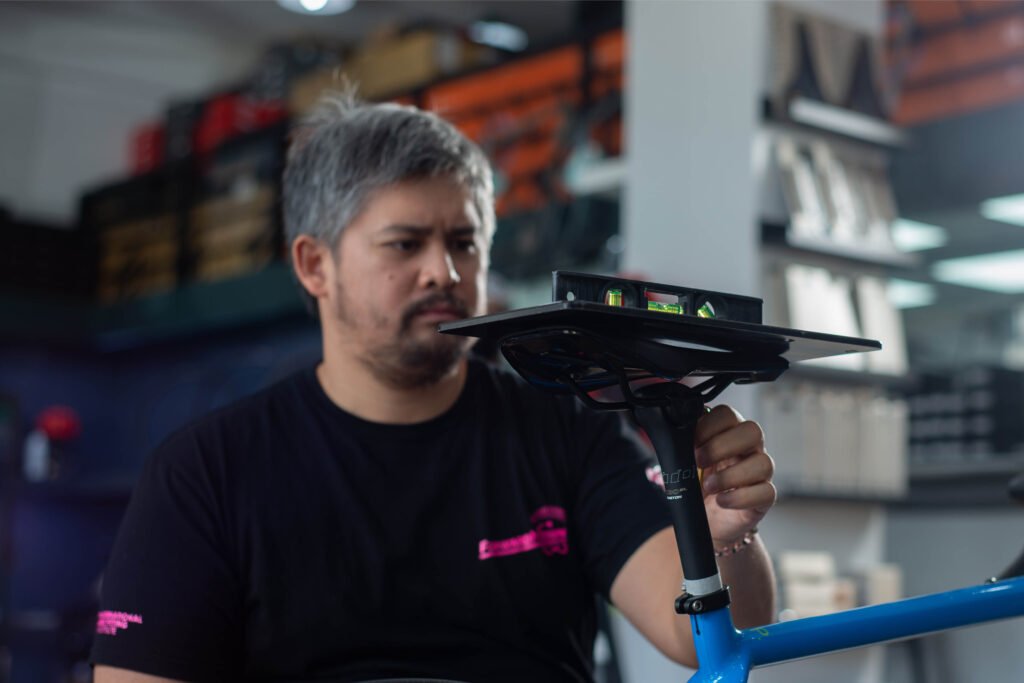

You mentioned that bike fitting is a specialized service. Are there a lot of practitioners of this craft locally? Is it a path that you’d recommend more people should take? What skills or qualities are required to succeed in bike fitting?
As far as I know, we have around a hundred or more, both certified and uncertified. Do I encourage people who are interested to learn this craft? Absolutely. The Philippines has a growing population of cyclists and the current number of bike fitters here cannot cater to everyone.
I actually have a 14-to-15-month waiting list. Some even offer to pay me more than the standard fee, but I tell them that I don’t do that. I think that’s one thing that I would advise to people who want to venture into bike fitting. Don’t do it for the money. Do it because you’re passionate about it, do it because you love it.
A tip would be to focus on the study of human anatomy and physiology. Understanding these things will help you learn more about the movements of the rider and the mechanical works. Learning to listen is important as well. Knowing how the rider thinks while they’re on their bicycle matters more than you expect!
For novices like us, what would you say is the most difficult part of your job? What is the easiest or almost second nature to you?
For me, the most challenging task would be fitting a bicycle to a rider who doesn’t have or know their own goals. This is why whenever I get an inquiry, I always ask the user to familiarize themselves with their own bike first, consistently do riding for a few months, and do basic adjustments of their own. This will make the actual bike fitting procedure a lot easier.
There is no easy task. Everybody gives you a different type of challenge. Everything is a learning experience. I always remind myself to not be too confident and make sure that I still have the necessary excitement and nervousness with every assignment. Doing so helps me do my job properly and make my clients happy.
Speaking of clients, has there been a memorable client encounter that you can share?
I’ll let you in on a secret. Should I see a client out of nowhere or just walk by them, even if they were a client almost or over 10 years ago, I remember the kind of problem that they gave me. Even without looking at my record, I know what they asked me to do and I know what I had to do for them to fit into their bicycle.
Every client is memorable for me. Each task is a new experience.
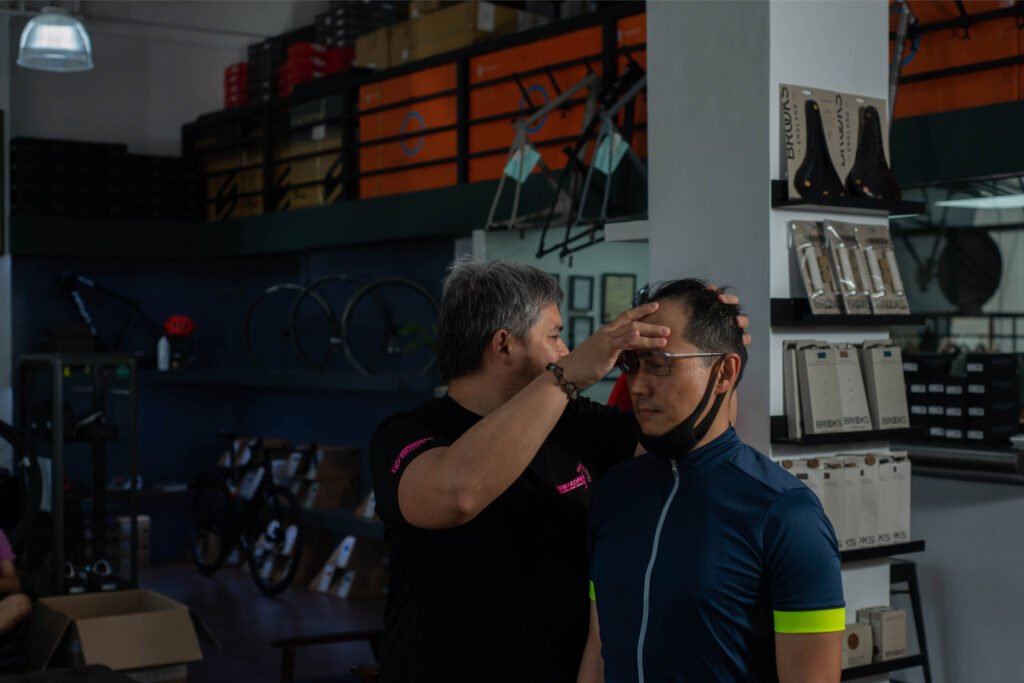

Let’s go a little macro this time. What can you say about the rise and prevalence of bike culture in the country today? What are the plusses and negatives you are seeing?
The pandemic inadvertently helped save the local cycling industry. Years ago, we felt like the industry was going down already. More fitness and riding activities were being explored by people such as Spartan, CrossFit, motorcycling, and the like which led to less attention being paid to cycling.
The pandemic pushed people to realize the practicality of bicycles not just for commuting but also for fitness and leisure and also caused a shift in interest. Now, we see more people who are very passionate about cycling.
The biggest drawback that we long-time enthusiasts are seeing is that as the number of bikers increases, so does the number who do not know how to ride a bike properly. Without proper riding ethics and road riding discipline, accidents can happen. This is why we need to push for information dissemination in terms of driver-rider respect and conduct more riding seminars.
We cannot deny that cycling infrastructure was rushed into existence during the pandemic. What ways do you think LGUs can make cycling around our towns and cities easier, safer, and attractive to new bike enthusiasts?
A good way of starting would be the provision of safe bike paths and lanes. We could go beyond the typical bike lanes on the road and create routes across forests or greenery, and have mini bike parks where riders can not only pass through but also enjoy the scenery. This can help riders not only physically but also mentally and emotionally.
Another thing would be to allot more parking spaces for bikes. LGUs can mandate buildings to have designated bike parking spots. An ideal one would be a space with showers and changing rooms where bikers can freshen up.
It would be smart for governments to invest in bicycle infrastructure now especially with the present traffic congestion and rising number of users. Climate change is also now a reality and the capacity of cycling to offer emissions-free transportation should be a fact our transportation and urban planners must acknowledge. It is an investment for our current and future generations.
I also believe that competitive cycling is a sport in which Filipinos could excel in, with the way we are built and our endurance.


“The biggest drawback that we long-time enthusiasts are seeing is that as the number of bikers increases, so does the number who do not know how to ride a bike properly.”


This may be too soon for me to ask, but does your son know how to ride a bike already?
Actually, he does! He’s into Striders, they are bikes without pedals that make learning to steer on two wheels smoother and easier. He won his first Strider race last summer.
What about your adventure? If you were to gauge, how near are you to the finish line in terms of bike fitting knowledge?
Bike fitting is a very young industry. Every year, they come up with different technologies and discover new techniques.
I don’t see myself nearing the finish line yet because I know that some time from now, new studies and learnings will arise and I’m always interested to know about those. You could say that the finish line progressively moves (laughs).
Bike fitting is a combination of art and science. It never ends. •
